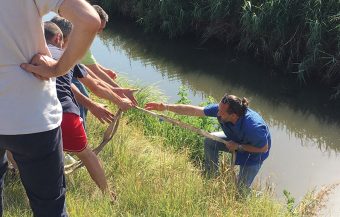The story of per- and polyfluoroalkyl substances (PFAS) begins with something not uncommon in science but requires a keen and careful eye. Namely, while working on the synthesis of new compounds in the 1940s, chemists at the DuPont Company did not achieve what they had planned, but they noticed that some compounds exhibited repellence to both water and oil. Humanity was introduced to a new patent commercially known as Teflon, a compound that nature had neither synthesized before nor since. Over the years, thousands of these compounds have found applications in numerous industries – for impregnating rain-resistant jackets and shoes, as an additive in firefighting foams, as coatings on the inner sides of fresh food packaging, in cosmetics, medicine, the automotive industry, and telecommunications devices.
Harmful Effects
However, PFAS contain one of the strongest covalent bonds in nature (carbon-fluorine), making them highly resistant to biodegradation, and their removal from the environment presents a significant challenge. By the end of the last century, scientists had detected the presence of PFAS compounds in water, plants, food, blood, and breast milk. Pandora’s box was opened, and in recent years, they have been found in water, soil, and numerous organisms. Their presence near factories that produced them is not surprising, but PFAS have also been detected in very remote areas, such as the Arctic and Antarctica. Furthermore, some studies suggest that exposure to PFAS compounds is associated with harmful health effects, including a reduced immune system response, elevated cholesterol levels, thyroid hormone disruption, reduced birth weight, and more.

Due to all the aforementioned, the use of these compounds is increasingly restricted, and maximum allowable concentrations in food and water are being regulated. PFAS compounds are a global challenge, highlighted by the Hollywood film Dark Waters, which depicts the ongoing battle of lawyer Robert Bilott against the DuPont Company.
Given the significant concern surrounding this environmental issue, a group of scientists from Serbia has gathered to develop innovative strategies to address the presence of PFAS compounds in the environment. The PhytoPFAS project team, funded by the Science Fund of the Republic of Serbia, is multidisciplinary and consists of fifteen researchers from the fields of chemical, biochemical, and physicochemical sciences from four scientific and educational institutions of the University of Belgrade – the Faculty of Chemistry, the Institute of Chemistry, Technology, and Metallurgy (ICTM), the Faculty of Physical Chemistry, and the Faculty of Medicine.
IN FOCUS:
- Furniture and Wood – The Driving Force of Bosnia and Herzegovina’s Wood Industry
- WWF Adria Supports Innovative Environmental Projects
- Citizen Participation in the Energy Transition: Towards a Fair and Inclusive Society
Application of New Technology
The main goal of the PhytoPFAS project, funded under the Green Program for Science and Industry Cooperation, is to develop the use of plants (phytoremediation) for cleaning polluted environments and establishing a solid foundation for applying this technology in collaboration with industry. The PhytoPFAS team will explore the possibility of PFAS compound uptake using different plants in soil and hydroponics.
After selecting the most efficient species, the plants will be tested at both the laboratory level and pilot scales. The next step involves the commercial application of the developed technology. Phytoremediation can be used to remediate existing pollution and prevent new contamination. The primary beneficiaries will be the broader population and industry, as the application of phytoremediation will contribute to a cleaner and healthier environment, more efficient use of natural resources, and reduced waste.
Researchers from the Faculty of Chemistry and the Institute of Chemistry, Technology, and Metallurgy at the University of Belgrade also coordinate another significant project related to PFAS compounds, PFAStwin, funded by the European Executive Agency for Research. This project is strengthening Serbia’s capacity for PFAS compound analysis and bioremediation.
The PhytoPFAS Project Team
The story was published in the new issue of the Energy portal Magazine ENERGY TRANSITION
